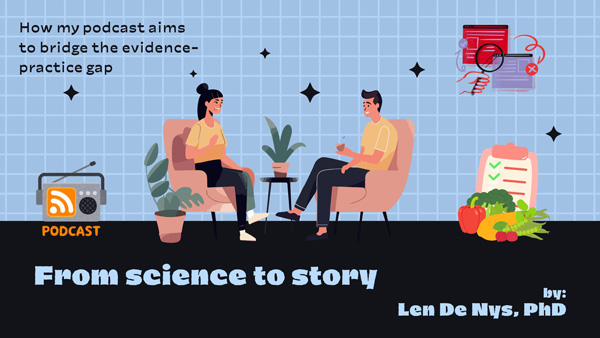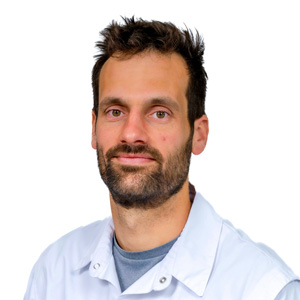From science to story: A podcast to bridge the evidence–practice gap
Introduction
Evidence alone doesn’t move people, but stories do. On World Evidence-Based Healthcare (EBHC) Day, I aim to demonstrate how a podcast can translate rigorous research on healthy lifestyle strategies into actionable narratives for clinicians, researchers and the public. My goal is simple: to bridge the research–practice gap through collaborative knowledge communication. This means putting experts, clinicians and communities in the same conversation and allowing evidence to travel further and faster.
Background
The show Je Levensstijl als Medicijn (Dutch for ‘Your Lifestyle as Medicine’ – hosted in Belgium) provides healthcare providers, researchers and other experts with a platform to share their latest findings and practice insights in plain language. Before each episode, the topic and expert are introduced on the podcast’s social media platforms (LinkedIn and Instagram), allowing the public to submit questions. The incoming questions are then synthesized into 3 to 5 concise prompts and prepared with the guest. After the episode airs, feedback and follow-up questions are encouraged, keeping the dialogue open.
This creates a co-production loop: audience questions shape the interview; expert insights address real-world needs; and community feedback guides the next episode.
‘When evidence meets story, and experts meet the public, knowledge no longer sits on a shelf—it lives, breathes and changes the way we care and live.’ – Len De Nys

The problem
We all know the familiar hurdles: a 17-year gap from research to routine care; technical language that excludes; and a digital ecosystem where misinformation spreads faster than corrections. Healthy lifestyle strategies attract ‘miracle cure’ narratives (quick fixes and one-size-fits-all protocols), making it harder for the public to trust cautious, qualified scientific messages.
The search for answers
The show leans on three podcast design principles:
1. Story first, stats second. Each episode opens with a short ‘Myth vs Fact’ or ‘FAQs’ lightning round to hook attention, followed by a deeper exploration. When a complex idea emerges, it is conveyed through a concrete metaphor—because mental images outlast bullet points.
2. Co-creation with the public. The expert and topic are pre-announced on social media to gather questions and turn them into episode scaffolds. This ensures we answer what people actually need, not only what we assume they need.
3. Transparent uncertainty. During the episode, it is explicitly explained why scientists hedge: the strength of evidence, heterogeneity and context. For example, we avoid ‘this works for everyone’ in favour of ‘this is where the weight of evidence lies’ and we often add a short personal (or patient) case to show variability in response.
Result/outcome
Two recent examples illustrate impact:
1) The cortisol masterclass: stress and sleep management for better (mental) health.
In the most-listened episode, the Cortisol Masterclass, listener questions clustered around ‘How do I apply stress management strategies in my life?’ from a parent juggling young kids and a demanding job to someone managing depression who wanted a step-by-step entry point. After the episode, targeted social posts were published with micro-actions (e.g. a five-minute wind-down routine, ‘two wins before 10 a.m.’ and a cue-based breathing habit). The feedback loop was immediate: direct messages (DMs) and comments from followers described specific changes (bedtime routines, phone-off windows, morning light exposure) and how these nudges felt doable rather than overwhelming.
2) Night-shift nutrition for nurses (eating at night).
‘What and when should I eat during night shifts?’ is a recurring question, especially from nurses. In response, a roadmap episode was recorded with two experts, translating chrono-nutrition into practical shift-friendly patterns: planned meal timing, hydration and simple night-safe snack constructions. Listeners reported testing the routine on their following shifts and noticing fewer energy crashes and easier post-shift sleep. The key was our evidence-to-behavior bridge: rules of thumb, not rigid rules.
Across episodes, downloads (200,000+), completion rates (~70%) and audience demographics (primarily Belgium and the Netherlands) are tracked through Spotify for Creators. Still, the most valued metric is qualitative: ‘I tried X you suggested—and it helped.’ I also see a spillover effect: invitations for public keynotes and DMs with personal questions or stories have grown as episodes tackle common clinical questions in accessible language.
How storytelling humanises evidence
- Starting with simple ‘Myth vs Fact’ and frequently asked questions (FAQs) makes it easier for people to engage and opens the door to curiosity about the more nuanced evidence.
- Using metaphors (e.g. the ‘dimmer switch’ for stress reactivity or ‘traffic lights’ for night-shift meals) turns abstract ideas into concrete, memorable images that guide action.
- Stories that centre on a patient’s journey, showing a relatable struggle, a credible path forward and a small but achievable win, encourage listeners to shift from passive learning to actively trying out healthy habits.
In short, stories carry evidence where statistics alone can’t.
Countering misinformation without losing trust
Two recurring myths addressed during the episodes are the notion of a one-size-fits-all solution and the promise of quick results. This is countered by firstly naming uncertainty up front (‘effects vary by context and baseline’) and pointing to the most substantial evidence to date, rather than absolutist claims. Second, offering graded options (good/better/best), so listeners can start somewhere, which beats abandoning change because perfection feels out of reach. And third, using personal or clinical mini-cases to show variability without undermining the evidence base.
This approach consistently earns comments like ‘Thanks for explaining the ‘why’ behind the caution—it makes me trust the conclusions more.’
Challenges, lessons and next steps
Communicating science through story-driven formats is rewarding, but it is not without its hurdles. Academic incentives rarely reward science communication, so progress is measured less in CV lines and more in trust and unexpected opportunities. Time is another bottleneck, as editing, visuals and distribution are demanding. However, tools like ChatGPT (for transcript highlights) and Canva (for visuals) can help alleviate this burden. The key is to systematise the workflow and deliberately block off uninterrupted time for the deep thinking and creative work that make the podcast valuable. The hardest balance is simplifying without distortion. Here, the lesson is to lead with humility and present uncertainty as a strength of good science, not a flaw.
Looking ahead, the next step is less about inventing new formats and more about refining the three core principles that bridge the gap between science and practice, as I have experienced. First, co-creating with the audience, letting their questions shape the narrative and translating evidence into practical first steps. Second, being transparent about uncertainty, clarity combined with humility builds trust and trust outlasts hype. Third, designing for action: pair every explanation with one small, testable behaviour that listeners can try this week. At the same time, I aim to stay current with emerging AI tools that can streamline production and make evidence more accessible.
Together, these experiences demonstrate that science communication is not just about sharing evidence; it is about creating a living dialogue where knowledge is translated, tested and trusted.
References
Rubin R. It takes an average of 17 years for evidence to change practice: The burgeoning field of implementation science seeks to speed things up. JAMA, 2023;329(16):1333-6.
Pitt MB, Hendrickson MA. Eradicating jargon-oblivion: A proposed classification system of medical jargon. J Gen Intern Med, 2020;35(6):1861-4.
Surjatmodjo D, et al. Information pandemic: A critical review of disinformation spread on social media and its implications for state resilience. Soc Sci 2024;13(8):418.
To link to this article - DOI: https://doi.org/10.70253/GCGW5427
Links to additional resources
Quote ‘When evidence meets story…’, translated from www.lendenys.eu
Je Levensstijl als Medicijn podcast: https://creators.spotify.com/pod/show/lendenys
Tiny habits: https://tinyhabits.com/
Disclaimer
The views expressed in this World EBHC Day Blog, as well as any errors or omissions, are the sole responsibility of the author and do not represent the views of the World EBHC Day Steering Committee, Official Partners or Sponsors; nor does it imply endorsement by the aforementioned parties.
